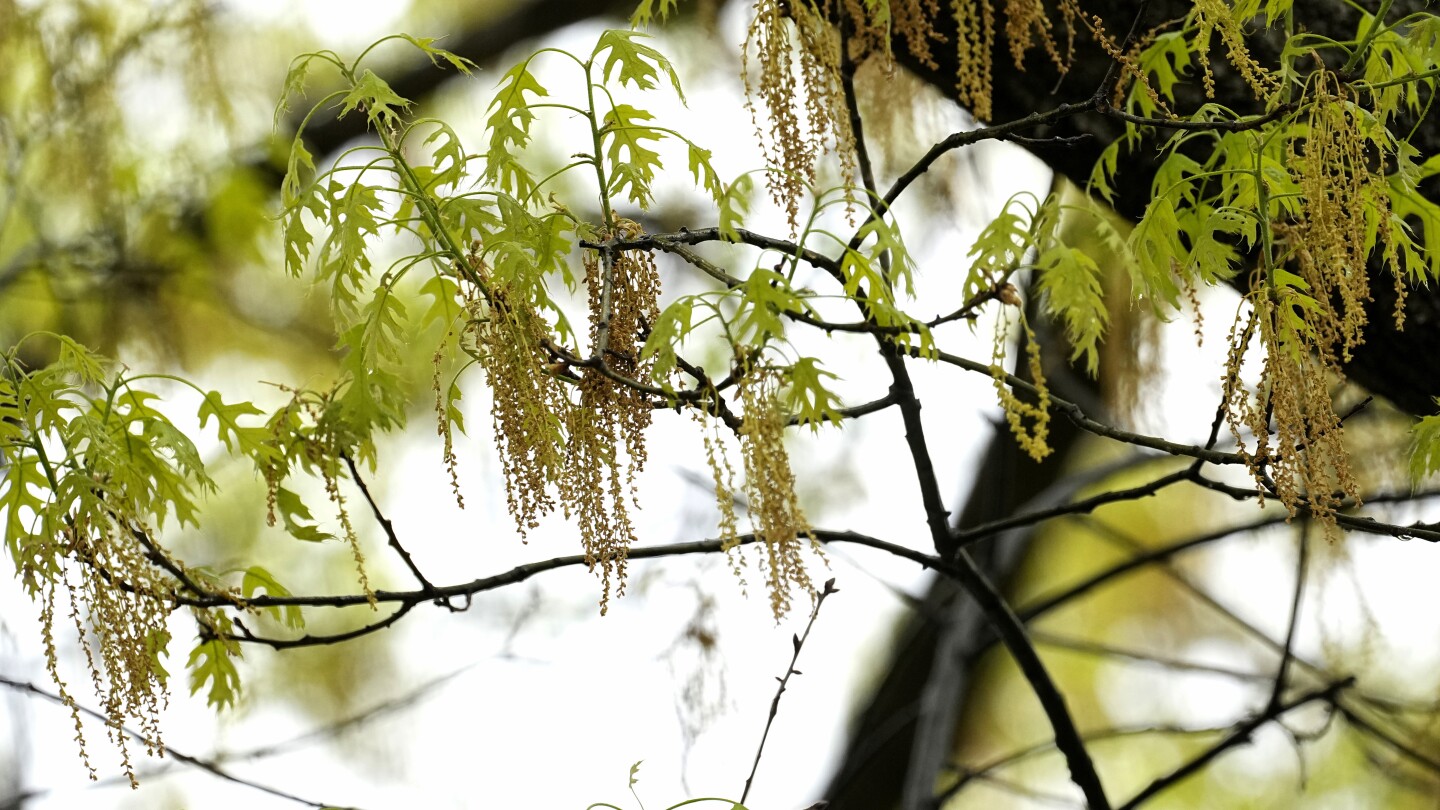Lifestyle
Is there more to fine dining? For this Mexican chef, it’s a path toward his country’s roots

MEXICO CITY (AP) — Quintonil is not your typical Mexican restaurant.
Clients book tables months in advance to celebrate special occasions. The World’s 50 Best list ranked it as the most acclaimed venue in the country in 2024 — and No. 7 worldwide. But once in a while something unexpected happens: food brings guests to tears.
“We have hosted people who have wept over a tamale,” said chef Jorge Vallejo, who founded Quintonil in Mexico City in March 2012.
He intentionally chose traditional street food for the menu — insects and other pre-Hispanic delicacies included. Priced at 4,950 pesos ($250 US) per person, it evokes the nostalgia of home and the history of the homeland.
The tamale — which translates from the Nahuatl language as “wrapped” — is a Mesoamerican delicacy made of steamed corn dough. It can be filled with savory or sweet ingredients — such as pork meat and pineapple — and topped with sauce.
Official records show that around 500 varieties of tamales can be found in Mexico. And according to a publication of Samuel Villela, ethnologist from the National School of Anthropology and History, Nahua communities used them for ritual purposes.
Most of Vallejo’s clientele are foreigners attracted by the two Michelin stars awarded to Quintonil last year. Others are nationals who spent decades living abroad or Americans of Mexican descent in search of a taste from their ancestry.
“They come to visit their families and feel shaken by the flavors that remind them who they are,” the chef said. “It’s like coming back to their roots.”
Providing that experience is what motivated him to open Quintonil 13 years ago. He first thought of his 11-table restaurant as a “fonda,” as Mexicans call popular food venues offering homemade dishes.
“I didn’t think I would own a restaurant like Quintonil nor did I aspire to that,” Vallejo said. “What I’ve tried to do is to learn from Mexico and show the best of it.”
He took his first job in a place resembling a fonda, where he and his mom used to have lunch. He then studied culinary arts.
For a while, he worked on a cruise line, peeling crabs and coordinating the logistics to feed thousands of clients. Back in Mexico, he met his wife and business partner at Pujol, run by famed chef Enrique Olvera. They founded Quintonil a few years later and their mission has not changed: We’ll tell our country’s tales through food.
“We all have a life story,” Vallejo said. “I try to interpret that and transform it into stories we can share at Quintonil.”
Traveling is part of his routine. He meets with colleagues to exchange anecdotes and contacts, but also encounters local farmers and spends time in remote communities to understand how food and tradition intertwine.
“In Mexico, we have ecosystems and ingredients that don’t exist anywhere else,” Vallejo said. “And our recipes, our traditions, are deeply rooted in society.”
His menu at Quintonil often incorporates insects, treasured since pre-Hispanic times.
Ancient documents describe how the Mexica were once established in the Chapultepec Hill. Its name comes from “chapulín,” a type of grasshopper that Mexicans currently enjoy from street vendors or at popular bars known as “cantinas.”
“In Mexico City, we have ‘escamoles’ season,” Vallejo said, referring to an edible larvae the Aztec people ate. “But in Oaxaca, we can find the ‘chicatana’ ants. In Tlaxcala, ‘cocopaches’ (a leaf-footed bug) and in Guerrero, they have insects of their own.”
Alexandra Bretón, a food enthusiast who has visited Quintonil several times and reviews restaurants in her blog “Chilangas Hambrientas,” feels that Vallejo’s contribution to Mexican gastronomy is invaluable.
“He has elevated Mexican ingredients,” Bretón said. “My memories of Quintonil are of dishes where herbs, insects and vegetables are taken seriously in dishes with great technique.”
During her last visit in February, she tasted a delicious tamale filled with duck. Her second favorite was a taco, which can be found at thousands of food spots, but Vallejo somehow transforms into an experience.
“What we do here are not just beautiful plates,” said Geraldine Rodríguez, Quintonil’s sous chef. “We aim to nourish people, to show what Mexico is.”
There was a time, she said, when fine dining was synonymous of foie gras and lobster. But Quintonil chose another path.
“We have an ancestral cuisine that comes from our grandmothers,” Rodríguez said. “So we respect those recipes and add the chef’s touch.”
The taco experience highlighted by Bretón is among those efforts. Several ingredients — insects, for instance — are offered in plates for clients to wrap in tortillas.
“Through that interaction, that ritual that we Mexicans own, we watch clients wondering if they’re grabbing the taco in a proper way,” Rodríguez said. “But we always tell them we just want them to feel at home.”
Working long shifts and aiming for perfection is not an easy task for the 60 people working at Quintonil.
Rodríguez can spend up to four hours selecting a handful of sprouts to decorate a plate. Other near-invisible, almost ritualistic tasks are performed daily. One of them is brushing the “milpa,” a textile that hangs from the terrace and was named after Mesoamerican fields where crops are grown.
In the end it’s all worth it, Rodríguez said, because Quintonil provides clients with moments that evoke special memories.
She, too, has seen Vallejo’s clients cry over food. One of them was her dad. It was his 50th birthday, she said, and while she was not an employee of Quintonil at the time, Vallejo greeted her warmly.
The menu of the day included “huauzontles,” a green plant commonly cooked as a bun-shaped delicacy dipped in sauce. It also bears history, as Aztec communities ate it and used it to perform religious rites.
Quintonil’s recipe added stir-fry tomato and a local cheese. “When he ate it, he started crying and said they reminded him of my grandma,” Rodríguez said. “I had never seen my dad cry over a plate.”
Vallejo has often expressed joy for the recognition that Quintonil has achieved. But in his view, a chef’s true success is measured by what he make his clients feel.
“Mexican cuisine is a connection to the land, to the ingredients,” he said. “It’s a series of elements that produce not an emotion, but a feeling. And for me, there’s nothing more amazing than provoking that.”
____
Associated Press religion coverage receives support through the AP’s collaboration with The Conversation US, with funding from Lilly Endowment Inc. The AP is solely responsible for this content.
Lifestyle
Allergy season: How to check pollen levels and alleviate symptoms

ATLANTA (AP) — Allergy season can be miserable for tens of millions of Americans when trees, grass, and other pollens cause runny noses, itchy eyes, coughing and sneezing.
Where you live, what you’re allergic to and your lifestyle can make a big difference when it comes to the severity of your allergies. Experts say climate change is leading to longer and more intense allergy seasons, but also point out that treatments for seasonal allergies have become more effective over the last decade.
Here are some tips from experts to keep allergy symptoms at bay — maybe even enough to allow you to enjoy the outdoors.
Where are pollen levels the worst this year?
The Asthma and Allergy Foundation of America issues an annual ranking of the most challenging cities to live in if you have allergies, based on over-the-counter medicine use, pollen counts and the number of available allergy specialists.
This year, the top five cities are: Wichita, Kansas; New Orleans; Oklahoma City; Tulsa, Oklahoma; and Memphis.
Which pollens cause allergies?
There are three main types of pollen. Earlier in the spring, tree pollen is the main culprit. After that grasses pollinate, followed by weeds in the late summer and early fall.
Some of the most common tree pollens that cause allergies include birch, cedar, cottonwood, maple, elm, oak and walnut, according to the Asthma and Allergy Foundation of America. Grasses that cause symptoms include Bermuda, Johnson, rye and Kentucky bluegrass.
This article is part of AP’s Be Well coverage, focusing on wellness, fitness, diet and mental health. Read more Be Well.
How do I track pollen levels?
Pollen trackers can help you decide when to go outside. The American Academy of Allergy Asthma and Immunology tracks levels through a network of counting stations across the U.S. Counts are available at its website and via email.
Limit your exposure to pollens
The best and first step to controlling allergies is avoiding exposure. Keep the windows in your car and your home closed, even when it’s nice outside.
If you go outside, wearing long sleeves can keep pollen off your skin to help ward off allergic reactions, said Dr. James Baker, an allergist at the University of Michigan. It also provides some sun protection, he added.
When you get home, change your clothes and shower daily to ensure all the pollen is off of you — including your hair. If you can’t wash your hair every day, try covering it when you go outside with a hat or scarf. Don’t get in the bed with your outside clothes on, because the pollen will follow.
It’s also useful to rinse your eyes and nose with saline to remove any pollen, experts said. And the same masks that got us through the pandemic can protect you from allergies — though they won’t help with eye symptoms.
How to relieve allergy symptoms
Over-the-counter nasal sprays are among the most effective treatments for seasonal allergies, experts said.
But the vast majority of patients use them incorrectly, irritating parts of the nose, said Dr. Kathleen Mays, an allergist at Augusta University in Georgia. She suggested angling the nozzle outward toward your ear rather than sticking it straight up your nose.
Over-the-counter allergy pills like Claritin, Allegra and Zyrtec are helpful, but may not be as effective as quickly since they’re taken by mouth, experts said.
Experts also said that if your allergy symptoms are impacting your quality of life, like causing you to lose sleep or a lack focus at work or school, it might be time to consider an allergist appointment for immunotherapies.
Some remedies for allergy relief that have been circulating on social media or suggested by celebrities — like incorporating local honey into your diet to expose yourself to pollen — have been debunked.
Dr. Shayam Joshi, an allergist at Oregon Health and Science University, said that’s because the flowers that bees pollinate typically don’t contain the airborne pollen that causes allergy symptoms.
Is allergy season changing?
With climate change, winters are milder and growing seasons are longer, meaning there’s more opportunity for pollen to stay in the air, resulting in longer and more severe allergy seasons.
In many areas across the country, pollen counts have broken decades of records. In late March, the Atlanta Allergy and Asthma Center measured a pollen count of over 14,000 grains per cubic meter, which is considered extremely high.
___
The Associated Press Health and Science Department receives support from the Howard Hughes Medical Institute’s Science and Educational Media Group and the Robert Wood Johnson Foundation. The AP is solely responsible for all content.
Lifestyle
The 250th anniversary of the Battles of Lexington and Concord opens debate over US independence
NEW YORK (AP) — The American Revolution began 250 years ago, in a blast of gunshot and a trail of colonial spin.
Starting with Saturday’s anniversary of the Battles of Lexington and Concord, the country will look back to its war of independence and ask where its legacy stands today.
The semiquincentennial comes as President Donald Trump, the scholarly community and others divide over whether to have a yearlong party leading up to July 4, 2026, as Trump has called for, or to balance any celebrations with questions about women, the enslaved and Indigenous people and what their stories reveal.
The history of Lexington and Concord in Massachusetts is half-known, the myth deeply rooted.
What exactly happened at Lexington and Concord?
Reenactors may with confidence tell us that hundreds of British troops marched from Boston in the early morning of April 19, 1775, and gathered about 14 miles (22.5 kilometers) northwest on Lexington’s town green.
Firsthand witnesses remembered some British officers yelled, “Thrown down your arms, ye villains, ye rebels!” and that amid the chaos a shot was heard, followed by “scattered fire” from the British. The battle turned so fierce that the area reeked of burning powder. By day’s end, the fighting had continued around 7 miles (11 kilometers) west to Concord and some 250 British and 95 colonists were killed or wounded.
But no one has learned who fired first, or why. And the revolution itself was initially less a revolution than a demand for better terms.
Woody Holton, a professor of early American history at the University of South Carolina, says most scholars agree the rebels of April 1775 weren’t looking to leave the empire, but to repair their relationship with King George III and go back to the days preceding the Stamp Act, the Tea Act and other disputes of the previous decade.
“The colonists only wanted to turn back the clock to 1763,” he said.
Stacy Schiff, a Pulitzer Prize winning historian whose books include biographies of Benjamin Franklin and Samuel Adams, said Lexington and Concord “galvanized opinion precisely as the Massachusetts men hoped it would, though still it would be a long road to a vote for independence, which Adams felt should have been declared on 20 April 1775.”
But at the time, Schiff added, “It did not seem possible that a mother country and her colony had actually come to blows.”
A fight for the ages
The rebels had already believed their cause greater than a disagreement between subjects and rulers. Well before the turning points of 1776, before the Declaration of Independence or Thomas Paine’s boast that “We have it in our power to begin the world over again,” they cast themselves in a drama for the ages.
The so-called Suffolk Resolves of 1774, drafted by civic leaders of Suffolk County, Massachusetts, prayed for a life “unfettered by power, unclogged with shackles,” a fight that would determine the “fate of this new world, and of unborn millions.”
The revolution was an ongoing story of surprise and improvisation. Military historian Rick Atkinson, whose “The Fate of the Day” is the second of a planned trilogy on the war, called Lexington and Concord “a clear win for the home team,” if only because the British hadn’t expected such impassioned resistance from the colony’s militia.
The British, ever underestimating those whom King George regarded as a “deluded and unhappy multitude,” would be knocked back again when the rebels promptly framed and transmitted a narrative blaming the royal forces.
“Once shots were fired in Lexington, Samuel Adams and Joseph Warren did all in their power to collect statements from witnesses and to circulate them quickly; it was essential that the colonies, and the world, understand who had fired first,” Schiff said. “Adams was convinced that the Lexington skirmish would be ‘famed in the history of this country.’ He knocked himself out to make clear who the aggressors had been.”
A country still in progress
Neither side imagined a war lasting eight years, or had confidence in what kind of country would be born out of it. The founders united in their quest for self-government but differed how to actually govern, and whether self-government could even last.
Americans have never stopped debating the balance of powers, the rules of enfranchisement or how widely to apply the exhortation, “All men are created equal.”
“I think it’s important to remember that the language of the founders was aspirational. The idea that it was self-evident all men were created equal was preposterous at a time when hundreds of thousands were enslaved,” said Atkinson, who cites the 20th-century poet Archibald MacLeish’s contention that “democracy is never a thing done.”
“I don’t think the founders had any sense of a country that some day would have 330 million people,” Atkinson said. “Our country is an unfinished project and likely always will be.”
Lifestyle
Sweets from the sky! A helicopter marshmallow drop thrills kids in suburban Detroit

ROYAL OAK, Mich. (AP) — It’s spring in Detroit — warm weather, a few clouds, and a 100% chance of marshmallow downpours.
The source? A helicopter zooming above the green lawn of Worden Park on Friday, unloading sack-fulls of fluffy treats for hundreds of kids waiting eagerly below, some clutching colorful baskets or wearing rabbit ears.
The children cheered and pointed as the helicopter clattered by on its way to the drop zone. Volunteers in yellow vests made sure kids didn’t rush in and start grabbing marshmallows until after the deluge was complete.
For anyone worried about hygiene, don’t fret. The annual Great Marshmallow Drop isn’t about eating the marshmallows — kids could exchange them for a prize bag that included a water park pass and a kite.
The marshmallow drop has been held for over three decades in the Detroit suburb of Royal Oak, Michigan, hosted by Oakland County Parks.
One toddler, Georgia Mason, had no difficulty procuring a marshmallow at her first drop, her dad Matt said.
“Probably the most exciting part was seeing the helicopters. But once we saw the marshmallows drop, we got really excited,” Matt Mason said.
“And, yeah, we joined the melee,” he said, “We managed to get one pretty easy.”
Organizers said 15,000 marshmallows were dropped in all.
The helicopter made four passes, dropping marshmallows for kids in three age categories: 4-year-olds and younger, 5-7-year-olds, and those ages 8 to 12. A drop for kids of all ages with disabilities came later in the day.
“We do it because it’s great for community engagement,” Oakland County recreation program supervisor Melissa Nawrocki said.
“The kids love it,” she continued. “The looks on their faces as they’re picking up their marshmallow and turning in the marshmallow for prizes is great.”
-

 Education1 day ago
Education1 day agoHarvard’s battle with the Trump administration is creating a thorny financial situation
-

 Conflict Zones1 day ago
Conflict Zones1 day agoTrump says US may ‘pass’ on helping end war if Russia, Ukraine resist deal | Russia-Ukraine war News
-

 Sports1 day ago
Sports1 day agoAaron Rodgers ‘not holding anybody hostage’ as he decides his future, retirement a possibility
-

 Lifestyle1 day ago
Lifestyle1 day agoSweets from the sky! A helicopter marshmallow drop thrills kids in suburban Detroit
-

 Europe1 day ago
Europe1 day agoLive updates: Trump news, Ukraine peace talks, US immigration, tariffs and university funding
-

 Sports2 days ago
Sports2 days agoNY Rangers’ Panarin, MSG reportedly made settlement payments after employee made sexual assault allegations
-

 Sports2 days ago
Sports2 days agoLos Angeles Rams honor first responders by conducting 2025 NFL Draft from Los Angeles Fire Department
-

 Europe1 day ago
Europe1 day agoRussia lifts terror group designation on Afghanistan’s Taliban




